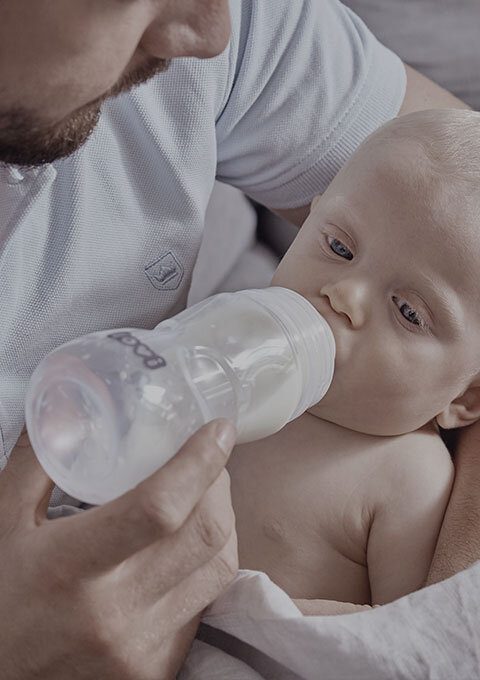Silicone, rubber, symmetrical, orthodontic, round, flat... The extensive range of bottle teats and soothers can leave you feeling overwhelmed. If you're breastfeeding and keen on preserving your baby's sucking reflex, opt for dynamic soothers and dynamic bottle teats. We explain why.
Dynamic bottle teats, as well as dynamic soothers, differ from standard teats and soothers in their construction. In standard teats and soothers, silicone has a uniform structure: the same thickness at the base and the tip of the nipple. Dynamic nipples, on the other hand, have non-uniform layers of silicone. In bottle teats, the base is firm and thick, while the tip is thin and soft. The same applies to soothers: the non-uniform silicone encourages the child to actively suck the soother, engaging in diligent effort.
According to Dr Aleksandra Łada, a clinical speech therapist, the shape and design of a soother should allow for unrestricted breathing and saliva swallowing, as well as not interfering with the natural sucking reflex. Opting for a silicone soother with a symmetrical shape and dynamic construction is advisable so that it doesn't disrupt the sucking rhythm and supports proper oral development.
The expert also emphasizes dynamism as a crucial feature to consider when choosing a feeding soother.
Dynamic bottle teats and soothers are worth choosing for several reasons:
The understanding of both nutritive (feeding) and non-nutritive (soothing) sucking processes, as well as the behaviour of the breast during suckling, has guided clinical speech therapists in creating dynamic teats and soothers. During the design of the teat and soother structures, factors such as the shape of the nipple, its dynamics in the baby's oral cavity, the coordination of sucking-swallowing-breathing during natural breastfeeding, the maintenance of a rhythmic sucking pattern, and the effectiveness of sucking were considered. To achieve appropriate soother parameters that support healthy sucking, the creation of silicone with non-uniform layers was necessary. This advanced technology could only be developed by experts highly specialised in infant feeding.
During breastfeeding, the nipple alternately elongates and contracts in the baby's mouth, engaging the muscles of the oral cavity in active work. The breast's areola provides stable support for the lips. In firmer bottle teats, the nipple’s tip cannot elongate, often causing changes in the baby's sucking rhythm. In softer bottle teats, the base collapses, leading to biting during feeding. However, dynamic bottle teats are constructed in such a way that the thin tip is soft and elongates similarly to a mother's nipple, while the firm base offers stable support for the baby's lips to rest in the appropriate position.
Often, babies who are accustomed to the dynamics of the breast during breastfeeding tend to prefer dynamic soothers and dynamic bottle teats. The movement of their nipples resembles the motion of a mother's nipple, which is familiar to them.
Thanks to the non-uniform silicone construction, these soothers and bottle teats elongate and contract in sync with the baby's sucking rhythm. They do not disturb the natural sucking reflex that babies are born with.
During breastfeeding, more than 40 muscles of the oral cavity (tongue, lips, cheeks, jaw) are engaged in a child's sucking motion. A bottle teat that closely mimics nature should stimulate the baby to actively suckle during feeding, similar to the breast, encouraging dynamic movement within the baby's mouth. This lays the foundation for the proper development of the baby's speech.
Dynamic bottle teats, thanks to their design, promote the correct coordination of sucking, swallowing, and breathing, while dynamic soothers allow for easy breathing and saliva swallowing. The intensive effort required when using dynamic bottle teats provides the baby with adequate oxygen and stimulates the development of the respiratory system.
You have just given birth. You look at yourself in a mirror and see rolls of fat on your hips, loose stomach muscles and stretch marks. It is natural, as nine months of pregnancy change woman's body.
Sleeping together with a baby has its ardent supporters and opponents. Regardless of your choice, whether you put the baby in his room, place his cot in your bedroom, or take the baby into your bed, it will have consequences ...
ivorce is most painful when divorcing people are not only spouses but also parents. It is impossible to conduct it in a way completely not affecting the child. However, together you can do everything possible to reduce his ...
